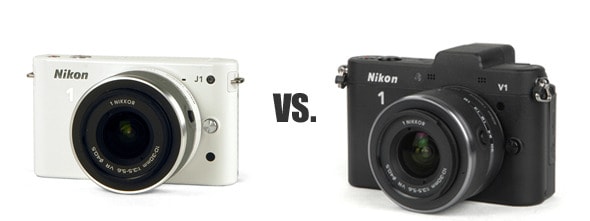Introduction

Section 1 Title
The Two Nikon Debutants
Section 1 Text
The Nikon V1 and Nikon J1 both incorporate some technologies that are new to interchangeable lens cameras for Nikon. The first is the mirrorless construction. Both cameras work similar to other mirrorless system cameras by displaying the image on the rear finder directly from the image sensor, rather than through an optical viewfinder. The Nikon V1 makes up for this by including an electronic viewfinder, which displays all the relevant shooting information from the rear display on the small eyepiece. The Nikon V1's EVF is quite good, easily among the better ones in this class of cameras, most of which only offer an EVF at a higher price point.
This lack of a mirror has another major drawback: autofocus performance. The Nikon V1 and Nikon J1 get around this by incorporating a line of autofocus sensors onto the image sensor itself, rather than on a separate dedicated autofocus sensor. This provides phase detection autofocus when shooting with the rear LCD or during video, something only Sony's line of SLT (not their mirrorless NEX cameras) can offer. It's very accurate, though it does begin to struggle in very low light levels along with its peers.
The major differences between the two cameras generally come down to the quality of components. The Nikon V1 includes the aforementioned optical viewfinder, but also benefits from a higher resolution rear screen (921k-dot resolution vs. 460k on the J1), a magnesium alloy body, a tacky rubber body covering for improved grip, a different battery for longer battery life, and an accessory port for external flashes and a GPS.
The J1 has a built-in flash in its favor (the V1 just has the accessory port, flash not included), but has a smooth, plastic body that is difficult to keep hold of. In particular, we found that gripping the J1 with gloves was incredibly difficult, and the lack of any sort of external grip made changing lenses on the go harder than it needed to be. On the inside, however, the Nikon V1 and J1 are practically identical.
Section 2 Title
Performance
Section 2 Text
The Nikon J1 and V1 performed very similarly in our tests, though the V1 gets the edge in our overall score (by about a point) thanks to its upgraded hardware. In our performance tests, however, you'd be hard-pressed to tell them apart.
First, to highlight the positives. Both cameras have remarkable capabilities in terms of speed for a compact system camera. Both cameras offer up to 60fps image capture at full resolution (exposure and focus locked) and around 5fps capture otherwise. The Nikon J1 and V1 both also feature 400fps and 1200fps high speed video, though at a slightly reduced resolution.
The two cameras were also capable of some fine color accuracy—when white balance issues were accounted for—and produced relatively clean shots at a low ISO with decent dynamic range.
In more challenging conditions, however, we saw the performance fall off by quite a bit. The small CX sensor of the Nikon J1 and V1, made by Aptina, holds up well against Micro Four Thirds but lacks the high ISO and dynamic range capabilities of Sony's NEX line of shooters. The biggest issue we saw with both cameras was a troubling lack of white balance accuracy or consistency. Both cameras displayed odd, frequent green and magenta biases, especially under artificial lighting.
Section 3 Title
Conclusion
Section 3 Text
Altogether, the Nikon V1 and J1 are both interesting concepts, with an excellent initial lens lineup but an image sensor that can struggle at times. Choosing between them is a matter of choosing between spec sheets, as performance doesn't differ in any meaningful way, making the J1 a solid value if you're stuck between the two. You'll have to live with the poor handling body and lack of an electronic viewfinder, but $250 is a large price gap to make up when there aren't performance hikes to go with it.
To read our full in-depth performance review of the Nikon V1, please visit here. To read our full performance review of the Nikon J1, you can click right here.
Section 4 Text
Section 5 Text
Meet the tester
TJ is the former Director of Content Development at Reviewed. He is a Massachusetts native and has covered electronics, cameras, TVs, smartphones, parenting, and more for Reviewed. He is from the self-styled "Cranberry Capitol of the World," which is, in fact, a real thing.
Checking our work.
Our team is here to help you buy the best stuff and love what you own. Our writers, editors, and experts obsess over the products we cover to make sure you're confident and satisfied. Have a different opinion about something we recommend? Email us and we'll compare notes.
Shoot us an email